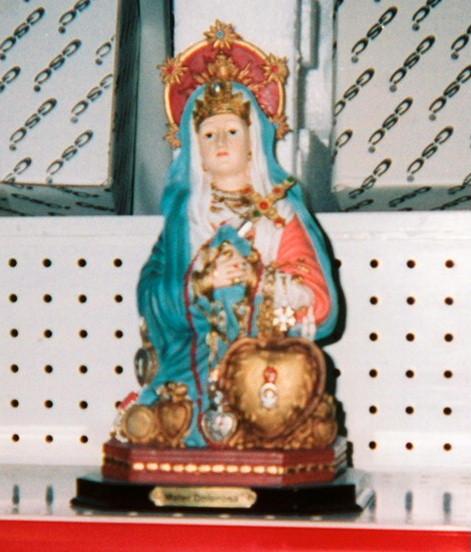
Mater Dolorosa, Mother of Sorrows,
La Donna de Dolorosa, Our Lady of Sorrows

Mater Dolorosa, Mother of Sorrows,
La Donna de Dolorosa,
Our Lady of Sorrows
Mater Dolorosa is one of the Latin titles of the Madonna, which means "Sorrowful Mother" or "Mother of Sorrows." She is the patron of Apulia, Italy. September 15 is the feast day honoring the Madonna as Mater Dolorosa or La Donna de Dolorosa. According to Sicilian tradition, mothers who are born on September 15 are especially blessed as healers or are said to have the healing touch.
In Catholic iconography, Mater Dolorosa is often represented with a sword piecing her heart and with an expression sadness or tears.
There are Seven Sorrows or Seven Dolors in the life of the Blessed Virgin Mary: (1) the Prophecy of St. Simeon the Old (Luke 2:34), (2) The Flight into Egypt (Matthew 2:13), (3) the Loss of the Child Jesus for Three Days (Luke 2:43), (4) the Meeting of the Madonna and her son, Jesus, along the Way of the Cross (Luke 23:26), (5) the Crucifixion where the Madonna stands at the foot of the cross (John 19:25), (6) the Madonna receives the dead body of Jesus in her arms in the Descent from the Cross (Matthew 27:57), (7) the Burial of Jesus (John 19:40).
It is a common Catholic devotion to recite a Hail Mary for each of these Seven Sorrows.
The prayer beads or Chaplet of the Seven Sorrows is dedicated to the Mater Dolorosa. This devotion was instituted in the 13th century. It is also refered to as the "Chaplet of the Seven Sorrows of the Mater Dolorosa," "Chaplet of the Seven Sorrows of Mary" or the "Seven Dolors Rosary." It has seven sets of seven beads, totaling 49 beads. Each set of seven beads is divided from the rest by medals representing the seven sorrows of the Madonna's earthly life. To offer prayers on this chaplet, the devotee prays 1 Hail Mary on each of the beads. On each of the 7 metals, the devotee recites 1 Our Father. As the devotee circles the string of beads, s/he meditates in turn on the seven sorrows while praying 7 Hail Marys. The prayer "Sorrowful and Immaculate Heart of Mary pray for us" is used as well. The devotee concludes the prayer cycle of this chaplet with 3 final Hail Marys in honor of the sorrowful tears of the Madonna.
Beginning on the crucifix, the devotee prays 1 Hail Mary. Then the devotee meditates on the seven sorrows while praying 7 Hail Marys. The prayer "Sorrowful and Immaculate Heart of Mary pray for us" is used as well. The devotee concludes on the crucifix, with 1 Our Father.
There is also a smaller set of prayer beads known as the Stabat Mater Dolorosa Chaplet, which is named after a hymn associated with the Mater Dolorosa. The Stabat Mater Dolorosa Chaplet has a loop of one set of ten beads with a crucifix. Beginning on the crucifix, the devotee prays 1 Hail Mary. Then the devotee sings one of the ten verses of the hymn "Stabat Mater" on each of the 10 beads.
The hymn, "Stabat Mater," dates from the 13th century, and originated with the Franciscans. Its title is from the first line of the Latin verse, "Stabat mater dolorosa" (The sorrowful mother stood). The "Stabat Mater" focuses on the suffering of the Mardonna, during the crucifixion of her son. In 1727, it was prescribed as a Sequence for Mass on September 15 to honor the feast day of Mater Dolorosa (the Sorrowing Mother) or La Donna de Dolorosa (our Lady of Sorrows). In addition to this Mass, the hymn is also used for the Office of the Readings, Lauds, and Vespers for this memorial.
A literal translation from the Latin into English can be found at: www.shrinesf.org/stabatmater.htm
"Pray to me in behalf of my mother's tears, I shall gladly grant them."
"I am the Mother of the hopeless; Mother of Sorrows. It is important for those that are suffering to come to me for consolation and for comfort."